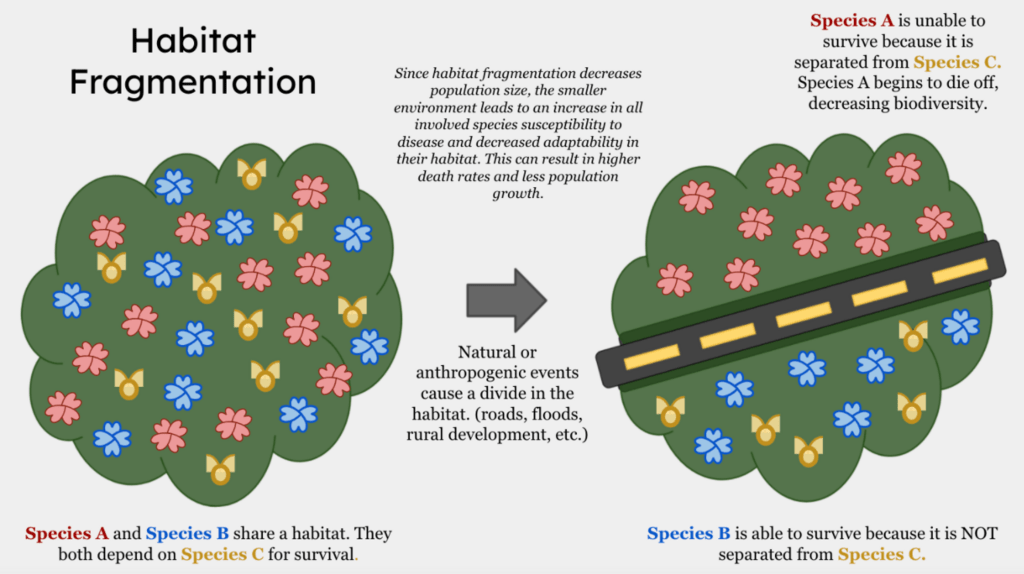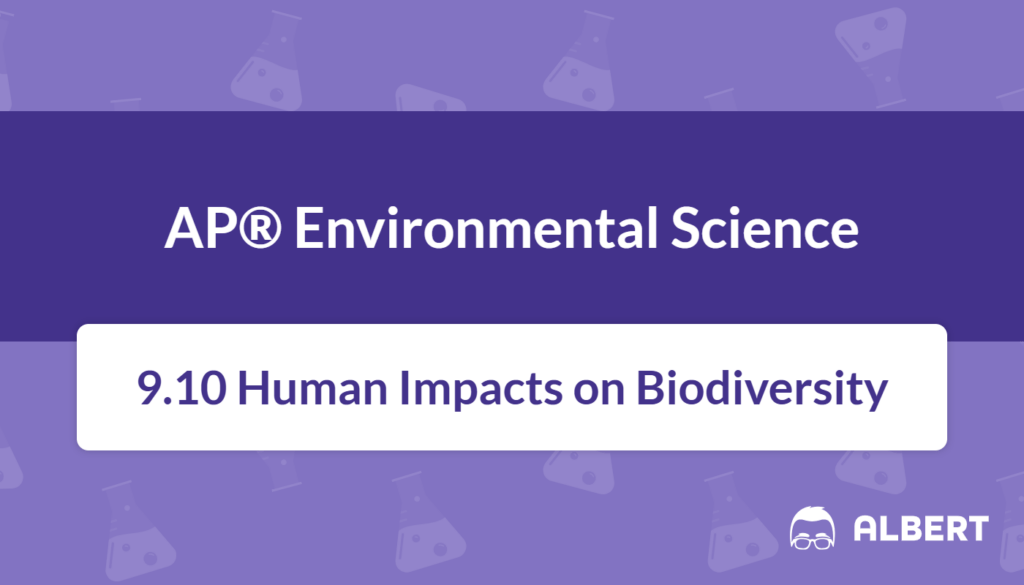What We Review
Introduction
Biodiversity refers to the variety of life on Earth, encompassing everything from microscopic organisms to massive redwood trees. Many ecosystems depend on a wide range of species to remain healthy, productive, and resilient. However, human activities continue to put pressure on the planet’s biodiversity in numerous ways. The human impact on biodiversity, such as habitat destruction or the introduction of invasive species, can reduce the number of species present and make ecosystems more fragile. Therefore, it is crucial to comprehend how human activities affect global biodiversity and to learn about strategies designed to mitigate this impact.
This guide examines the main factors driving biodiversity loss, often summarized by the HIPPCO framework: habitat destruction, invasive species, population growth, pollution, climate change, and overexploitation. In addition, it explores related concepts such as habitat fragmentation and domestification, which can both decrease biodiversity. By the end of this guide, you will understand how these factors interact and what can be done to combat the problem.
What Is Biodiversity?
Biodiversity describes the variety of life in a particular habitat or across the entire biosphere. It includes three key forms:
- Genetic Diversity: Variation in the genetic makeup within a single species.
- Species Diversity: The number and abundance of different species in a given area.
- Ecosystem Diversity: The distinct types of ecosystems (e.g., forests, grasslands, wetlands) and their interactions.
Biodiversity is essential because it underpins ecosystem health and stability. High levels of genetic and species diversity can help ecosystems withstand disturbances such as disease outbreaks or extreme weather events. Moreover, humanity depends on biodiversity for food, medicine, and ecosystem services like pollination and water purification. Consequently, preserving a range of species and genetic traits is vital for supporting life on Earth and ensuring resources for future generations.
The HIPPCO Framework
The HIPPCO framework simplifies the various threats facing biodiversity into six categories:
- Habitat Destruction
- Invasive Species
- Population Growth
- Pollution
- Climate Change
- Overexploitation
These factors often work together, leading to decreased biodiversity. For instance, human population growth can lead to more development, which in turn causes habitat destruction. In other cases, pollution from industrial activities may weaken species’ resilience, making them more vulnerable to diseases.
Example: HIPPCO in Action
Consider a small coastal wetland near an expanding city. First, the wetland’s size shrinks due to construction projects (habitat destruction). Next, residents might introduce non-native plant species to decorate nearby yards (invasive species). As the human population increases (population growth), more pollutants from vehicles run into the wetland (pollution). Rising temperatures caused by climate change lead to changes in plant growth and water temperature (climate change). Finally, local fishermen may harvest too many fish, leaving key predator populations too low (overexploitation). Step by step, each factor reshapes the wetland community, illustrating how HIPPCO can drastically alter biodiversity in a short time.
Habitat Fragmentation
Habitat fragmentation occurs when a large, continuous stretch of habitat is broken into smaller, isolated patches. Construction of roads, pipelines, settlement expansions, and logging are common causes. Although one might assume a forest with many clearings still provides enough trees, these fragments create barriers for species that rely on movement across larger areas.
Moreover, smaller habitats often support fewer species. Top predators and wide-ranging animals may struggle to find enough territory, while prey species may face a higher risk of predation. Consequently, the composition of species changes, leading to decreased biodiversity over time. Therefore, understanding habitat fragmentation is a critical step in preserving ecosystems and their inhabitants.

Example: Effects of Habitat Fragmentation
Imagine a dense forest split by a highway. Before construction, species such as bobcats or wolves could roam freely. Afterward, each side of the forest stands as a smaller patch. Step by step:
- Predators struggle to cross the highway safely, reducing their hunting grounds.
- Prey populations may soar in the absence of natural predators.
- Invasive grasses may fill clearings along the roads, crowding out native plants.
- Edge effects (drier or hotter conditions at forest edges) begin to alter plant growth, pushing certain species into the forest interior.
Over time, these shifts reduce genetic diversity and alter the forest’s entire species structure.
Climate Change and Biodiversity
Climate change is reshaping habitats worldwide by altering temperature patterns, precipitation levels, and sea levels. Many species rely on specific temperature ranges or breeding seasons that correspond to local climate conditions. When those conditions change, organisms must adapt, migrate, or risk extinction.
Changing precipitation patterns might transform wetlands into arid grasslands, diminishing the local diversity of birds and amphibians. Rising sea levels can submerge coastal habitats, displacing species that cannot move inland. Therefore, climate change is an overarching challenge for biodiversity, impacting almost every ecosystem.
Example: Climate Change Effects on Organisms
One illustrative example is coral reefs. When ocean temperatures rise:
- Corals expel the algae living in their tissues, a process called coral bleaching.
- Without algae, corals lose their vibrant color and a key energy source.
- Fish species dependent on reef habitats may leave, reducing the reef’s overall diversity.
- Commercial fisheries then suffer economic losses, illustrating how changes in biodiversity can affect humans.
This chain reaction shows that a single shift in environmental conditions can cause cascading effects throughout an ecosystem.
Domestification and Its Impact
Domestification is the process of adapting wild plants or animals for human use, often to increase productivity. Over centuries, humans have domesticated species like cattle, wheat, and honeybees. While domestication can provide stable food sources, it can also reduce genetic diversity within these species. For instance, breeding practices might favor traits that improve yield but diminish a population’s resilience to disease.
Another concern is that domesticated species may compete with their wild counterparts for resources. Although the term “domestication” usually implies human control, its broader ecological effects must be considered. Therefore, it is important to balance economic benefits with conservation goals to maintain overall ecosystem function.
Example: Domesticated Species
Consider honeybee colonies managed for commercial pollination in large orchards. Step by step:
- Farmers import honeybee colonies to pollinate crops.
- The honeybees outcompete local wild pollinators for nectar and pollen.
- Fewer resources remain for native pollinator species.
- Reduced numbers of wild pollinators make the surrounding ecosystems less stable, since many plants depend on diverse pollinator types.
- As genetic variety among honeybee colonies narrows, the bees become more vulnerable to disease.
This example highlights how domestification can clash with the goal of sustaining wild pollinator populations.
Strategies to Combat Biodiversity Loss
Although the challenges facing biodiversity are serious, there are ways to mitigate the damage. Various strategies focus on protecting, restoring, and wisely managing ecosystems. When combined, these actions can help slow or even reverse biodiversity declines.
Common strategies include:
- Creating protected areas: National parks and wildlife reserves provide critical refuges for at-risk species.
- Using habitat corridors: Corridors connect isolated habitat patches, allowing species to move more freely.
- Promoting sustainable land use: Responsible agriculture and forestry practices aim to preserve natural resources while meeting human needs.
- Restoring lost habitats: Efforts like replanting forests or reintroducing native species can rehabilitate degraded areas.
Example: Creating Protected Areas
Imagine that a government designates a large grassland region as a protected area. Step by step:
- Clear boundaries are set, limiting development and agricultural expansion.
- Local species, including keystone predators, gain enough territory to maintain healthy population levels.
- Scientists study the area’s environmental conditions to monitor improvements in species diversity.
- Ecotourism programs introduce visitors to the region’s natural beauty, creating economic incentives for conservation.
- Over time, the grassland recovers, strengthening both the local economy and the environment.
These actions demonstrate how protected areas can give ecosystems the space they need to thrive.
Conclusion
Human impacts on biodiversity can be understood through the factors of HIPPCO: habitat destruction, invasive species, population growth, pollution, climate change, and overexploitation. Habitat fragmentation divides larger habitats into smaller ones, making it difficult for many species to survive. Climate change intensifies habitat threats, forcing species to relocate or risk extinction. Domestification adds another layer by reducing genetic diversity and sometimes displacing wild species.
Nevertheless, strategies exist to combat biodiversity loss. Creating protected areas, restoring habitats, and ensuring sustainable land use practices can all contribute to the preservation of vital ecosystems. Learning more about these approaches and taking steps to implement them can help maintain the diverse web of life upon which humans also depend. Increased awareness and action at the individual, community, and global levels are key to safeguarding Earth’s rich biodiversity for generations to come.
Key Vocabulary
- Biodiversity: The variety of life in an area, including genetic, species, and ecosystem diversity.
- Habitat Fragmentation: The breaking of larger habitats into smaller, isolated patches due to activities like road building or logging.
- Domestification: The process by which humans adapt wild species for economic or agricultural purposes, often reducing genetic diversity.
- Climate Change: Long-term alterations in temperature, precipitation, and other atmospheric conditions that affect ecosystems.
- Overexploitation: The unsustainable harvesting or use of species, which can lead to population decline or extinction.
Sharpen Your Skills for AP® Environmental Science
Are you preparing for the AP® Environmental Science test? We’ve got you covered! Try our review articles designed to help you confidently tackle real-world AP® Environmental Science problems. You’ll find everything you need to succeed, from quick tips to detailed strategies. Start exploring now!
- AP® Environmental Science: 9.7 Review
- AP® Environmental Science: 9.8 Review
- AP® Environmental Science: 9.9 Review
Need help preparing for your AP® Environmental Science exam?
Albert has hundreds of AP® Environmental Science practice questions, free response, and full-length practice tests to try out.








